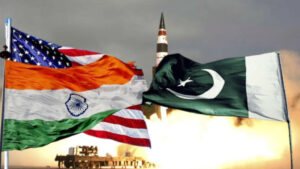By Luqman Ali
Pakistan has witnessed a decline in industrial output, attributed to factors such as reduced firm efficiency, power supply shortages, and limited innovation. The study draws inspiration from China’s industrial success story, highlighting the importance of long-term strategies and efficient policy implementation. It underlines the need to shift focus towards local industries and manufacturing to drive economic transformation while maintaining agricultural development. The article discusses the historical context of Pakistan’s industrial policies and examines the impact of various reforms, emphasizing the significance of internal stability, infrastructure development, and foreign partnerships.
Pakistan is currently grappling with a contraction in its industrial production, which has adverse effects on overall economic growth. This decline in industrial productivity can be attributed to several factors, including reduced efficiency among firms, a persistent shortage of power supply – a crucial pillar of industrial growth, and a lack of innovation. In April 2023, Pakistan’s industrial productivity plummeted by 21.1% year over year, following a 24.5% drop in the previous month. This stands in stark contrast to the peak productivity levels witnessed in 2000 and the alarming record low of -45% in 2020. (Growth, 2023)
Pakistan has made consistent efforts to bolster its industrial and manufacturing sectors, implementing various reforms throughout its history. However, challenges such as policy implementation gaps, political instability, and other significant obstacles have hindered the pace of growth in Pakistan’s local industrial sector, resulting in a contraction of industrial development.
According to a report by the Pakistan Business Council, in 2005, manufacturing and local industries contributed 17.5% to the state’s GDP. Yet, by 2022, this contribution had dwindled to 12.4%. This decline in manufacturing has also been reflected in Pakistan’s share of global exports, rendering the country highly reliant on imports and contributing to trade deficits and high unemployment rates. While countries worldwide have harnessed new techniques and innovations in their industrial sectors to advance, Pakistan has, unfortunately, lagged behind, standing even further behind its 2005 position. (Council, 2022)
Pakistan has a history of economic reforms aimed at boosting local industrial growth. Beginning with its first industrial policy in 1948, crafted in response to trade embargoes imposed by India, the nation focused on developing local industries through protectionism, trade barriers, and import substitution. In the 1970s, another significant economic reform saw the government take control of ten major industries, a move that eroded private sector confidence. The 1980s ushered in new industrial policies, emphasizing that the government could not arbitrarily seize control of industries and allowing private sector participation in infrastructure, power generation, and industrial development. Despite these efforts, subsequent reforms failed to strengthen the industrial and manufacturing sector due to inadequate policy implementation, resulting in deindustrialization and a loss of market share on the global stage. Despite a liberal investment regime, investments in local industries struggled to gain traction due to frequent energy shortages and the high cost of doing business. (Nisar, 2017)
In the contemporary arena the new industrial policies should revolve around a “Make in Pakistan” theme and be driven by three key success metrics including creation of jobs, increase in value added exports and import substitution. [Pakistan Business Council]
While there is ample literature on Pakistan’s industrial and manufacturing crisis, there is a notable absence of discussions on how to enhance these sectors and learn from China’s remarkable local industrial and manufacturing growth. China’s development trajectory, from poverty to prosperity in the 1970s, is a testament to its impressive economic journey. From 1978 to 2023, China’s GDP soared from 3.67 billion RMB to 59.3 trillion RMB. Today, China is often referred to as the “factory of the world,” excelling in production and competition, challenging the previously dominant industrial firms. China’s success can be attributed to proactive and targeted industrial policy-making, with a pronounced focus on innovation, a core objective of China’s economic agenda. It is impossible to envision the modern world without China, yet three to four decades ago, this outcome appeared vastly different. China’s political system was viewed with skepticism, with predictions of a potential collapse. However, China defied these expectations, achieving remarkable economic development without undergoing the anticipated political transformation. (Sano, 1999)
Pakistan possesses the capacity to develop its local industries and manufacturing sector by drawing valuable lessons from China’s strategies for promoting local industries and fostering innovation. No state in the world is born with a silver spoon; every nation must strive diligently for its stability and prosperity, and Pakistan has the capability to do just that.
In my personal opinion the foremost requirement for the development of local industries and manufacturing sectors is internal stability. Peace and stability within the country are paramount for initiating development. There is no instance in the world of a nation excelling in local industries and manufacturing without achieving internal peace and stability. China also prioritized internal peace, a critical factor in attracting foreign direct investments (FDI). There exists a perception about Pakistan’s security and instability that deters foreign companies and firms from investing in the country, as they perceive their investments as insecure. Thus, stability and peace are fundamental for industrial growth.
There are several key aspects to foster the growth of local industries in Pakistan. Firstly, they advocated for state ownership of enterprises and comprehensive support in terms of finances, legal backing, and the provision of a skilled workforce. Without these forms of state support, local industries would struggle to compete effectively in the market. The second critical element highlighted was the need for policies and a legal framework that are investment-friendly such as tax exemptions. Lastly, government’s legal framework should be simplified, establishing a one-window operation. This approach would significantly ease the process for individuals looking to start new local industries. Instead of navigating a complex and lengthy process, potential entrepreneurs could visit a single department to submit their applications, with that department responsible for obtaining approvals and providing the necessary NOCs from different departments and stakeholders. Such a simplified process would facilitate investment and the expansion of local businesses, ultimately contributing to the growth and strength of local industries.
In my findings Pakistan possesses abundant natural resources. Pakistan has the potential to utilize these resources just as China’s success in promoting domestic manufacturing .In the northern regions of Pakistan, there is a rich variety of fruits and other valuable resources. While Pakistan currently exports these raw materials to international markets, a more strategic approach would be to develop local expertise and techniques for transforming these raw materials into value-added products, such as various flavored jams and other derivatives. This transformation can lead to the establishment of local industries. The government needs to prioritize education and technological advancement, providing access to relevant skills training program. This approach mirrors China’s strategy, where they invested heavily in education, technology, and local manufacturing capabilities to strengthen their domestic industries.
Pakistan should prioritize policies that focus on technology transfers, particularly from its close and dependable ally, China. While acknowledging the development of Special Economic Zones under the (CPEC) project, they stressed the need for technology transfer from China to Pakistan. This transfer would involve not only the sharing of advanced technology but also the provision of comprehensive training to enable the local production and assembly of products, reducing dependence on imports. The second critical point was the establishment of Chinese banks in Pakistan. Main reason behind this proposal is to make low to medium-level loans easily accessible to local investors under favorable terms. The presence of these Chinese banks would facilitate effective monitoring, accountability, and checks on how investors utilize the capital. This step aims to ensure that the investments are channeled into the establishment and improvement of local industries, rather than being diverted for other purposes, which has been a prevalent issue in Pakistan.
Drawing inspiration from China’s strategy of protecting its local industries from international unfair competition, I will found that Pakistan should strategically implement tariffs and trade barriers to safeguard its own local industries. In order to promote local industries, Pakistan can explore opportunities to replace certain imported goods with domestically produced alternatives from its local industries. This approach involves actively supporting local manufacturers and encouraging them to produce goods that are currently being imported.








